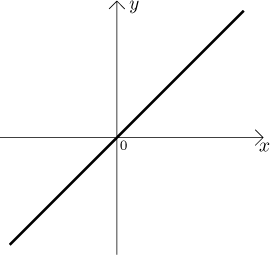
Definition.
The identity function, denoted Id, is defined for real numbers byId(x) = x.
The graph:

This is actually a familiar function, one of the simplest linear functions,
so why do we single it out? It has a special meaning if we look at functions
from the point of view of algebra and treat them as algebraic objects. Recall
the concept of
composition of functions. If
we look at the properties of composition as an operation on a set of real
functions, we find that it has some properties that we know from
multiplication, but lacks others.
We know that composition is not commutative, in fact compositions
What does work? Composition is associative, that's one thing. Another
interesting property is that, and here we are getting to it, it has a
unity. By a unity we mean a certain element which, when applied (using
the operation in question) to an arbitrary element, does not change it.
With multiplication it is the number 1. Indeed,
which means that
which means that
We just showed that
For the sake of completeness we remark that when we have a unity, we can ask
for an inverse, and just like with multiplication of real numbers, we do have
a notion of inverse element for functions and the composition. Indeed, the
inverse function
We actually cheated a bit here. The composition with inverse gives the identity function only if the function in question has the whole real line as both its domain and its range. On other cases we have to modify the equalities a bit, which brings us to the next topic.
Definition.
Let M be any subset of real numbers. We define its identity function IdM by
IdM(x) = x for x from M.
So we have
Note that the identity function we introduced above is just a special case of
this last definition, it is an identity function on the set of real numbers.
Conversely, we can view
Definition.
Let M be any subset of real numbers. We define its characteristic function by
The strange X is actually the Greek letter "chi". There is also an alternative notation, the characteristic function of a set M is denoted 1M. It also has another name, some people call it the indicator function of the set M. A third possible notation is IM, but it is perhaps the worst, since some people are lazy to write "d" and use just IM for the identity function above, so it is easy to mix them up. The first notation is the most widespread, but since Greek letters are a real pain on the Web, I will use in Math Tutor the second one, with boldface 1.
Example: In the picture we show the graph of the characteristic function of the indicated set M.

Characteristic functions of sets are very useful, often they are used to express "restriction" of a function to some set. Why the quotes? Restriction means that we cut off some pieces of the domain. Here we have a situation when we keep the original domain, but we are only interested in the values of the function on some part of it, so we make the function zero elsewhere.
Precisely, let f be a function defined on some set M and let N be some subset of M. Let g be the function that has the same value as f on N but is zero elsewhere on M.

Then g can be written as
Indeed, if x is from N, then
while for x that is from M but not from N we have
For another way of expressing characteristic function see the next section on the Heaviside function.